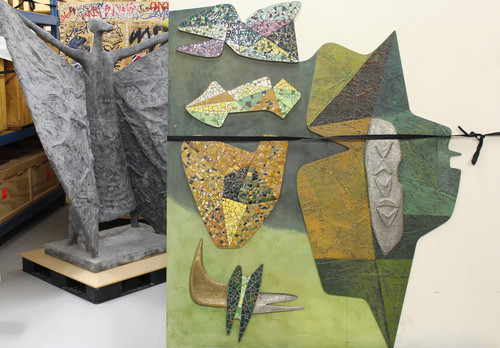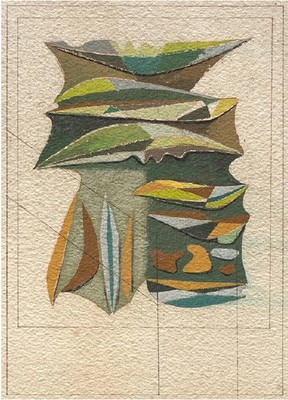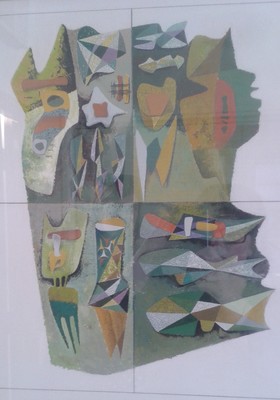B.
An architectural modernist relic
Behind the scenes
With so many 'old dungers' banished to oblivion in these parts, it's now difficult to find evidence, within the four avenues at least, that Christchurch had existed at all before, say, about 1983...
That's only a slight exaggeration. So it means that if you're looking for architectural evidence that this city had existed in - say - the 1950s, it's not going to happen. But here's something: a large mural from that period that had once been installed in the (now demolished) T & G Insurance Building. It's one of many architectural commissions completed by Christchurch artist / illustrator / sculptor / university lecturer Russell Clark (1905-1966).

Detail from T & G Mural, with Clark's Beach Figure behind.
The mural exists in four large panels, and came to the Gallery in 1992, probably when the T & G building was sold. Against a varigated green background it features an array of raised amorphous and geometric shapes.

Reworked domestic crockery.
Some of these resemble fish, fishhooks or carved whakairo motifs, and many feature ceramic mosaic - apparently reworked domestic crockery. The panels also include a number of handworked copper, brass and pewter forms.

Russell Clark Sketch drawing for T & G Building mural. Reproduced courtesy of Rosalie Archer
The mural dates from 1958, and is strongly of its time - it's a great object. When it came to the Gallery it was accompanied by a small, initial presentation sketch, which although similar is really very different to the finished piece.
A few weeks ago, shortly before we moved out of the Gallery, the mural was assessed by a local conservator. It needs cleaning and there is damage to be remedied (visible in the top image, in the bottom left corner). One corner that had extended beneath a staircase was painted over completely. Immediately to the right of this area, a burnished white patch showed that a piece was missing, presenting us with questions as well as challenges.

Russell Clark T & G Building mural, finished design sketch. Reproduced courtesy of Rosalie Archer
Shortly after moving into our temporary new quarters, I tacked an A4 photograph of the mural above my desk. Soon afterwards, a visitor was surprised to recognise it as an exact match to a painting (above) in her own collection - Russell Clark's finished design sketch. Apart from being an important and interesting drawing in its own right, it also provides vital information that can assist with the repair of the sculptural relief.
Even better is the fact that the piece that we knew was missing - visible in the finished design sketch as a double-pronged, brown shape - was very recently located in one of our conservation stores.
![Untitled [T & G Mural]](/media/cache/06/88/0688998014b44834fcf0fd81683e2169.jpg)